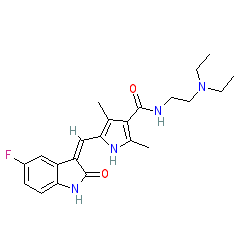GtoPdb is requesting financial support from commercial users. Please see our sustainability page for more information.
|
Synonyms: SU11248 | Sutent®
sunitinib is an approved drug (FDA and EMA (2006))
Compound class:
Synthetic organic
Comment: Sunitinib is a Type-1 kinase inhibitor and was first approved by the US FDA and EMA in 2006.
Ligand Activity Visualisation ChartsThese are box plot that provide a unique visualisation, summarising all the activity data for a ligand taken from ChEMBL and GtoPdb across multiple targets and species. Click on a plot to see the median, interquartile range, low and high data points. A value of zero indicates that no data are available. A separate chart is created for each target, and where possible the algorithm tries to merge ChEMBL and GtoPdb targets by matching them on name and UniProt accession, for each available species. However, please note that inconsistency in naming of targets may lead to data for the same target being reported across multiple charts. ✖
View more information in the IUPHAR Pharmacology Education Project: sunitinib |
|
|||||||||||||||||||||||||||||||||||
| No information available. |
Summary of Clinical Use  |
| Approved for the treatment of advanced renal cell carcinoma and gastrointestinal stromal tumours. Marketed formulations contain sunitinib malate (PubChem CID 6456015). In November 2017, the FDA expanded approval to include treatment of adult patients at high risk of recurrent renal cell carcinoma following nephrectomy, based on positive outcomes from clinical trial NCT00375674. |
Mechanism Of Action and Pharmacodynamic Effects  |
| Sunitinib inhibits multiple receptor tyrosine kinases, some of which are implicated in tumour growth, pathologic angiogenesis, and metastatic progression of cancer. Biochemical and cellular assays (including proliferation assays) have identified sunitinib, and its primary metabolite (desethyl sunitinib, PubChem CID 10292573), as inhibitors of platelet-derived growth factor receptors (PDGFRα and PDGFRβ), vascular endothelial growth factor receptors (VEGFR1, VEGFR2 and VEGFR3), stem cell factor receptor (KIT) [6], Fms-like tyrosine kinase-3 (FLT3) [4], colony stimulating factor receptor Type 1 (CSF-1R), and the glial cell-line derived neurotrophic factor receptor (RET). |
| Clinical Trials | |||||
| Clinical Trial ID | Title | Type | Source | Comment | References |
| NCT00375674 | A Clinical Trial Comparing Efficacy And Safety Of Sunitinib Versus Placebo For TheTreatment Of Patients At High Risk Of Recurrent Renal Cell Cancer | Phase 3 Interventional | Pfizer | ||
External links  |
|
For extended ADME data see the following: Electronic Medicines Compendium (eMC) Drugs.com European Medicines Agency (EMA) |








